|
Walther has started shipping their
highly-anticipated .380 polymer-framed auto pistol; the PK380. I
first saw a prototype of this new pistol at the 2009
SHOT Show, and have been eagerly awaiting the arrival of a
production gun. It is here, and I have been running a lot of
ammo through this one for the past couple of weeks. Walther has
been in the .380 auto pistol business for many decades now, and
introduced what was the first commercially successful
double-action auto pistol in 1928, the legendary Model PP,
followed shortly thereafter with the more compact Model PPK.
Entering into the highly-popular .380 polymer
pistol market now with the PK-380, Walther did not choose to go
after the micro pistol market, instead building the PK380 as a
moderately-sized auto pistol, making it easier to hold and shoot
well than the much smaller .380 pistols on the market. By size
and weight, the PK380 is very close to the Bersa
Thunder .380 pistols. However, instead of using a blowback
action, the Walther uses a locked breech short-recoil design.
One of the primary advantages to this is that the PK380 does not
have to use an excessively stiff recoil spring. While that might
not be important to many, it is very important to those who
might not have sufficient hand strength to pull back the slide
in order to load most semi-auto pistols. The slides of some
small pistols are very hard to operate for someone with
arthritis, or for anyone that does not have a lot of strength in
their hands. I get a lot of email from older shooters and women
who have problems working the slide on an auto pistol. The
Walther PK380 has one of the easiest to operate slides on any
centerfire auto pistol, taking about ten pounds of pressure to
retract the slide.
The PK380 has an eight-shot stainless steel
magazine, for a total loaded capacity of nine. It is perfectly
safe to carry the PK380 with a cartridge in the chamber. The
pistol has an ambidextrous hammer-block thumb safety, in
addition to a firing pin block. The firing pin cannot contact a
primer unless the trigger is pulled. The PK380 has a traditional
double action/single action operating mechanism. In normal use,
the pistol is carried with the hammer down and a live round in
the chamber. Releasing the thumb safety and then pulling the
trigger fires the first round double action, with subsequent
rounds fired in the single action mode. The thumb safety is not
a hammer-drop, but merely rotates a block of steel to prevent
the hammer from contacting the firing pin. The hammer can then
be safely lowered manually. The double action trigger pull
measured ten and one-quarter pounds on the sample pistol, and
the single action pull measured four pounds, thirteen ounces.
Both trigger pulls felt good and smooth. For my hand, the
trigger has a bit too much curve to it. It would be more
comfortable with a straighter trigger blade, or one that is a
bit longer. I find that my finger contacts the tip of the
trigger, but I have a fat trigger finger. Yours may be
different. There is plenty of room inside the trigger guard for
a gloved finger, for use in Winter.
The PK380 has an internal key lock, to
prevent unauthorized use of the pistol, and the same key is used
to disassemble the pistol. The ambidextrous magazine
release is easy to use with the trigger finger of either hand,
and also with the thumb of either hand, whichever the user
prefers. The design of the magazine release assures that the
magazine will not be accidentally dropped by bumping the
holstered pistol against any object, as can happen with other
designs. The grip is very comfortable to my hand. It is
well-designed to fit the human hand, and makes firing the PK380
a pleasure. The sights are large and easy to use, being a three
white dot design, and the rear sight is adjustable for windage
correction. There is an accessory rail on the frame just forward
of the trigger guard, to attach laser sights or flashlights, if
desired.
The PK380 is a compact pistol, but still
allows a full grip for good control. The PK380 is much easier to
shoot well and control than the smallest .380 pistols on the
market, but is also a bit harder to conceal. The PK380 will fit
into a front jeans pocket, but is best carried in a holster.
Carried in something like the Cross
Breed Supertuck, the pistol hides easily and rides
comfortably. The PK 380 weighs in at 19.1 ounces on my scale,
with an empty magazine in place. The barrel measures 3.72 inches
in length, and the overall length is six and one-half inches,
with a height of 5.18 inches, including the sights and magazine
extension.
I tested the PK380 for reliability and
accuracy using every type of .380 ammo available to me.
Reliability was one hundred percent. There were no failures to
feed, fire, or eject any cartridge. It doesn’t get any better
than that.
Velocities are listed in feet per second
(fps) in the chart below. HP is a jacketed hollowpoint bullet.
FMJ is full metal jacket. HC is a hard cast lead bullet. Glaser
is a specialty round with compressed lead shot in a bullet
jacket topped with a plastic ball. PB is PowRBall,
another specialty load from Cor-Bon. DPX is a load using the
Barnes X homogenous copper hollow nose bullet. Bullet weights
are listed in grains. Velocities were recorded twelve feet from
the muzzle. The air temperature during velocity testing hovered
around the fifty degree Fahrenheit mark.
| Ammunition |
Bullet Weight |
Velocity |
| Buffalo Bore HC |
100 |
1134 |
| Buffalo Bore FMJ |
95 |
1035 |
| Buffalo Bore HP |
90 |
1132 |
| Cor Bon PB |
70 |
1281 |
| Cor Bon DPX |
80 |
1050 |
| Cor Bon Glaser |
70 |
1166 |
| Cor Bon HP |
90 |
1010 |
| Handload HP |
90 |
862.4 |
| Remington FMJ |
90 |
913.3 |
| Remington HP |
88 |
926.5 |
Velocities posted were pretty respectable,
and are higher than velocities recorded from the smaller .380
auto pistols tested in the past. Accuracy was also good. With
combat ammo, I could keep every shot on the torso of a standard
silhouette target at twenty-five yards, firing rapid fire from a
standing position. I could do the same into the head of the
target at seven yards. Recoil is very controllable firing rapid
fire from this PK380, with even the most powerful .380
ammunition. Testing for accuracy from a bench rested position at
twenty-five yards, groups between two and one-half and three
inches were recorded with every brand tested, and the Buffalo
Bore hard cast doing better than that, grouping five shots into
two inches, when I did my part.
The Walther PK380 is a dandy auto pistol for
defense, either at home or when carried concealed. It is
reliable, accurate, and easy to shoot well. The slide operates
easier than any other centerfire auto of which I am aware. The
pistol points naturally, and is easy to handle.
Check out the PK380 and other Walther
products online at www.waltheramerica.com.
For the location of a Walther dealer near
you, click on the DEALER FINDER at www.lipseys.cpom.
To order the PK380 online, go to www.galleryofguns.com.
To order the high performance .380 ammo shown
here, go to www.buffalobore.com
and www.cor-bon.com.
Jeff
Quinn
| For a list of dealers where you can
buy this gun, go to: |
|
To buy this gun online, go to: |
 |
|
 |
|
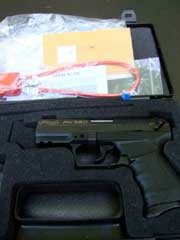
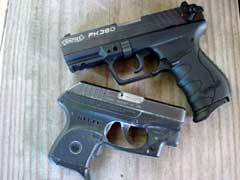
Size comparison: Walther PK-380 (top) and Ruger's
LCP (bottom).


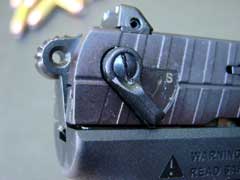
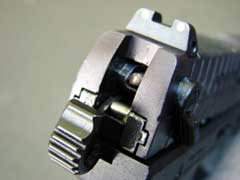
Ambidextrous safety lever blocks hammer from
touching firing pin.
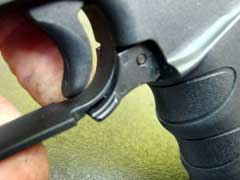
Magazine release is also ambidextrous.
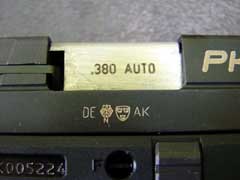
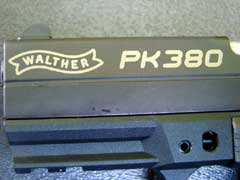
|
  
Got something to say about this article?
Want to agree (or disagree) with it? Click the following link to
go to the GUNBlast Feedback Page.
|
|
Click pictures for a larger version.
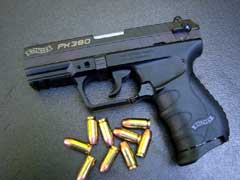
Walther's PK380 semi-auto .380 pistol.
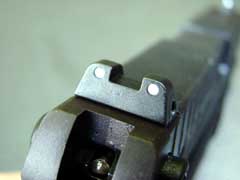

"Three-dot" sights.
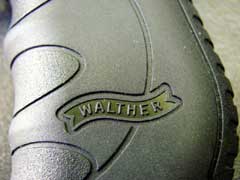
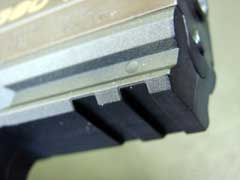
Accessory rail.
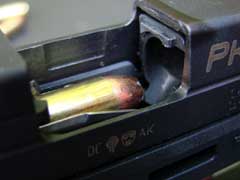
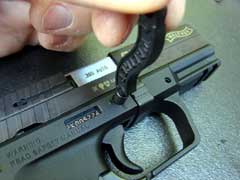

Internal lock.

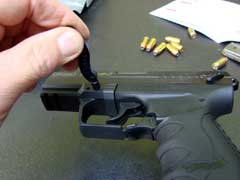
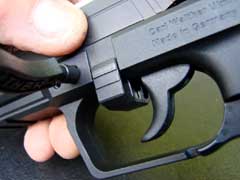
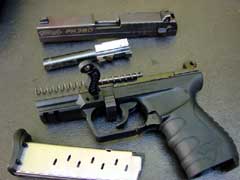
Disassembly requires use of tool provided.
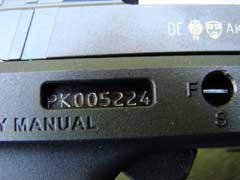

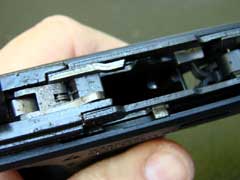
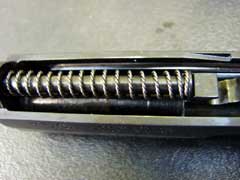
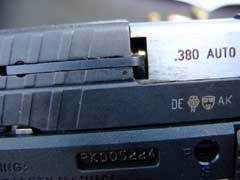
Loaded chamber window.

Author's three favorite loads for the PK-380 (left to
right): Buffalo Bore 90 grain Gold Dot Hollowpoint, Buffalo
Bore 100 grain hard cast lead, Cor-Bon DPX.

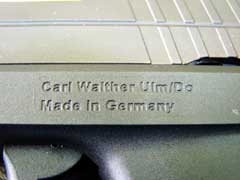
|
![]()